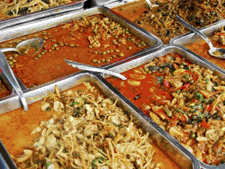 |
3 WAYS BUSINESSES CAN TARGET CONSUMER FOOD WASTE (Part II)
Americans love convenience, and throwing away unwanted food is very convenient. So, how can businesses target consumer food waste?”
Consumer food waste reduction strategies fall into three categories: 1. Helping customers buy less food. 2. Helping customers use food they buy. 3. Helping customers understand the impacts of food waste.
1. Helping customers buy less food--only what they need. Reducing restaurant food portions can reduce food waste (and overeating) when done creatively. Table 24 restaurant in Orinda, CA, has two kids’ menus: the Middles Menu for children ages 10 to 16 and the Littles Menu for children age 9 and under. They do this to attract families with multiple kids―a 2-year-old does not eat as much food as a 13-year-old, and a 12-year-old does not eat an adult portion. They notice that the portions are right-sized and plate waste is minimal.
Another Bay Area restaurant, The Sunny Side Caf�, serves reduced portions of home fries and offers free refills to its customers. Or try cutting portions without cutting prices, as Las Vegas’ MGM Grand Hotel did to reduce food waste. Customers perceived good value even though they received less food for their money, and plate waste went down 15-20% during an 18-month period.

Buffet settings provide two other food waste reduction opportunities―trayless dining and cook-to-order service. By switching to trayless dining, college campuses throughout the country have reduced consumer food waste by approximately 30% (plus achieved big savings in water, energy and cleaning products). And by transitioning to a cook-to-order approach, the MGM Grand buffet, for one, is saving $8,000 a month in food costs, contributing to an 80% reduction in food waste and nearly 10% increase in customer satisfaction scores.
2. Helping customers use food they buy. Restaurant customers generally don't eat 17% of served food and leave 55% of potential leftovers on their plates, according to the NRDC. Restaurants can encourage customers to take home leftovers and provide guidance on using them. In 2004 Buca di Beppo restaurants partnered with the American Dietetic Association and ConAgra Foods to develop food safety labels for leftover and carryout containers.
According to a 2009 restaurant survey, US customers are looking for this type of guidance: 34% of diners wanted to know when leftovers were no longer safe to eat and 43% wanted instructions on storing, reheating and serving. In a prior 2004 survey, a full 75% of diners said they wanted this guidance.
3. Helping customers understand the impacts of food waste. Think of food waste as a subject for customer dialogue. Wasting food means wasting money. But most Americans don’t know that the average household spends $2,200 per year on wasted food.
When people understand the dollar impacts, they can be motivated to change their behaviors. This certainly has been true in the UK, where Waste & Resources Action Programme’s Love Food, Hate Waste campaign showed people how "it pays to be a Food Lover,” contributing to an 18% reduction in household food waste between 2006 to 2007 and 2010.
In buffet settings, where food waste has zero cost to consumers, other incentives work better. Food-service distributor Sodexo launched a Stop Wasting Food campaign at college campuses in 2010, which focused on curbing climate change instead of saving money. The campaign calls on students to take two small steps to curb climate change―take only what they plan to eat, and come back for more if they are still hungry.
Without a doubt, changing customer behaviors around food waste is very challenging. The best advice is to investigate these options and envision new ones that fit your business and your customers.
Himmelfarb, Nancy, 3 ways businesses can target consumer
food waste, Greenbiz.com, Febrary 14, 2013
To learn more about GHA and how your property can be greener, jump to
"Green" Hotels Association ®!
|

"GREEN" IDEA!
 Scrape the plate. Before washing dishes, utensils, pots or pans, scrape them clean with paper towels. This helps remove both food scraps as well as grease that can clog drains.
Scrape the plate. Before washing dishes, utensils, pots or pans, scrape them clean with paper towels. This helps remove both food scraps as well as grease that can clog drains.







greenhotels.com
|
|
Unique Visitors |
Hits |
2012
|
| Apr |
11,283 |
726,114 |
| May |
10,997 |
667,475 |
| June |
9,515 |
578,873 |
| July |
9,883 |
580,884 |
| August |
9,809 |
590,792 |
| September |
10,135 |
541,873 |
| October |
11,185 |
650,824 |
| November |
12,040 |
641,196 |
| December |
10,301 |
490,242 |
| TOTAL 2012 |
130,827 |
8,115,839 |
2013
Jan | 10,947 |
536,184 |
| Feb |
10,849 |
555,803 |
| Mar |
12,693 |
937,200 |
| TOTAL 2013 |
96,303 |
6,292,524 |

|
 |



